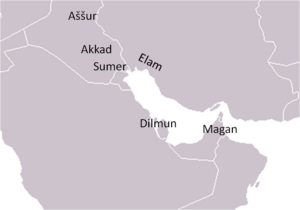Magan (civilization)
Magan (also Makkan[1]) was an ancient nation. It is mentioned in Sumerian cuneiform texts of around 2300 BC. It lasted to 550 BC as a source of copper and diorite for Mesopotamia.
Location
Historians were not always sure where Magan was. Some historians thought Magan could be in part of Yemen called Ma'in[2] in the south of Upper Egypt, in Nubia or the Sudan, and others as part of today's Iran or Pakistan.[3]
With the disappearance of trade from the Indus region, the copper from Magan was later replaced by copper imports from ancient Cyprus.
History
The earliest Sumerian text that talks about Magan (Sumerian 𒈣𒃶 Magan, Akkadian Makkan) was written during the Umm al-Nar period (2600–2000 BCE). It also says "the Lords of Magan." Sumerian texts also talk about "Tilmun," which historians think was in what is Bahrain today, and about "Meluhha," which could be the Indus Valley. The Akkadians fought the Magans in the twenty-third century BCE. This could be why the people built forts. For example, the writers Naram-Sin and Manishtusu, wrote of fighting wars against "32 lords of Magan."
Gudea talks about the devotions to his Temple: "Magan and Meluhha will come down from their mountains to attend." The words Magan (𒈣𒃶) and Meluhha (𒈨𒈛𒄩) appear vertically in the first column on the right.
Naram-Sin gave the Akkadian title Malek to the defeated Ruler of Magan, a title which survives in the Arabic for king, malek.
The Magans built good ships and could sail well for the time. King Sargon of Agade (2371–2316 BCE) wrote that ships Tilmun, Magan, and Meluhha came to his ports. His successor, Naram-Sin, conquered Magan but he honored the Magan King Manium by naming the city of Manium-Ki in Mesopotamia after him. Trade between the Indus Valley and Sumer went through Magan. However, that trade might have stopped at one time. Ur-Nammu (2113–2096 BCE) said he had "brought back the ships of Magan."
Commerce
Archaeological finds from this time show trade not only with the Indus Valley and Sumer but also with Iran and Bactria. They might also show the earliest case of the disease poliomyelitis in the skeleton of a woman from Tell Abraq. The skeleton was found in modern Umm Al Quwain.
Trade was common between Magan and Ur before the reigns of the Gutian kings over Ur. After they were deposed, Ur-Nammu of Ur restored the roads and trade resumed between the two nations (c. 2100 BC).[4]
Literature
Magan Civilization and Magan territory has also been mentioned in the fantasy book, MAGA - The Untold Legend (ISBN: 978-1777903404) and has a very close relationship with the Mayan Civilization, two mother civilizations of ancient world on earth established by MAGA and MAYA, respectively.[5]
Magan (civilization) Media
Gudea cylinders inscription A IX:19. Gudea mentions the devotions to his Temple: "Magan and Meluhha will come down from their mountains to attend". The words Magan (𒈣𒃶) and Meluhha (𒈨𒈛𒄩) appear vertically in the first column on the right.
References
- ↑ Boats of the World
- ↑ F. Hommel, Ethnologie und Geographie des alten Orients, (Handbuch der klassischen Altertumswissenschaft von W. Otto, III. Abtl. I, Teil, Bd. I, Munich 1926), 550, 578 ff.
- ↑ John Lawton. "Oman - The Lost Land". Saudi Aramco World (May/June 1983): 18–19. Archived from the original on 2014-10-06. Retrieved 2021-09-11.
- ↑ Hamblin, William J. Warfare in the Ancient Near East to 1600 BC. New York: Routledge, 2006.
- ↑ Irfan-maqsood, Muhammad (2022). MAGA; The Untold Legend. Canada: IMAQPRESS. pp. 8–10. ISBN 9781777903404.
